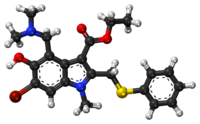Umifenovir
You can help expand this article with text translated from the corresponding article in Russian. (June 2020) Click [show] for important translation instructions.
|
This article needs more primary sources. (July 2020) |  |
 | |
 | |
| Clinical data | |
|---|---|
| Trade names | Arbidol |
| Other names | AR-1I9514 |
| Pregnancy category |
|
By mouth (hard capsules, tablets) | |
| ATC code | |
| Legal status | |
| Legal status | |
| Pharmacokinetic data | |
| Bioavailability | 40% |
| Metabolism | Hepatic, CYP3A4[4] |
| Elimination half-life | 17–21 hours |
| Excretion | 40% excrete as unchanged umifenovir in feces (38.9%) and urine (0.12%)[3] |
| Identifiers | |
| |
JSmol) | |
| |
| |
| | |
Umifenovir, sold under the brand name Arbidol, is an antiviral medication for the treatment of influenza and COVID infections used in Russia[5] and China. The drug is manufactured by Pharmstandard (Russian: Фармстандарт). It is not approved by the U.S. Food and Drug Administration (FDA) for the treatment or prevention of influenza.[6]
Chemically, umifenovir features an indole core, functionalized at all but one positions with different substituents. The molecular groups of umifenovir - hydroxy, amino and carboxy - can interact to form various hydrogen-bonded synthons. Antiviral activity and acceptable cytotoxicity profiles [7][8] make it a promising candidate for further research as a potential therapeutic agent for the selective treatment of flavivirus infections [9]. Umifenovir is characterized by only one polymorphic form but can exist in the form of a large number of crystal solvates, the production of which depends on the medium and conditions of synthesis. In this case, the implementation of the crystal solvate or other solid form may be determined by the spatial structure and conformational equilibria in the saturated solution [10][11]. The drug has been shown in studies to inhibit viral entry into target cells [12] and stimulate the immune response.
Status
Testing of umifenovir's efficacy has mainly occurred in China and Russia,[13][14] and it is well known in these two countries.[15] Some of the Russian tests showed the drug to be effective[13] and a direct comparison with oseltamivir showed similar efficiency in vitro and in a clinical setting.[16] In 2010 Arbidol was the drug brand with the highest sales volume in Russia.[17] In the first quarter of 2020 it had a 16 percent share in the Russian antiviral market.[18]
Mode of action
Biochemistry
Umifenovir inhibits membrane fusion of influenza virus.
Some evidence suggests that the drug's actions are more effective at preventing infections from RNA viruses than infections from DNA viruses.[20]
As well as specific antiviral action against both
Clinical application

Umifenovir is used primarily as an antiviral treatment for influenza. The drug has also been investigated as a candidate drug for treatment of hepatitis C.[22]
More recent studies indicate that umifenovir also has in vitro effectiveness at preventing entry of Zaire ebolavirus (Kikwit strain), Tacaribe arenavirus and Kaposi's sarcoma-associated herpesvirus in mammalian cell cultures, while confirming umifenovir's suppressive effect in vitro on Hepatitis B and poliovirus infection of mammalian cells when introduced either in advance of viral infection or during infection.[23][24]
Side effects
Criticism
In 2007, the Russian Academy of Medical Sciences stated that the effects of Arbidol (umifenovir) are not scientifically proven.[26]
Russian media criticized lobbying attempts by Tatyana Golikova (then-Minister of Healthcare) to promote umifenovir,[27] and the unsubstantiated claim that Arbidol can speed up recovery from flu or cold by 1.3-2.3 days.[28] They also made claims that comparative clinical studies have proven umifenovir to be inefficient.[29][30]
Names
Arbidol is the INN.[31]
The brand name Arbidol is known as Russian: Арбидол and Chinese: 阿比朵尔.[citation needed]
Research
In early 2020 umifenovir was touted as a potential treatment for COVID-19 in China, where it was sometimes given to patients in combination with other drugs such as the anti-HIV drug Darunavir.[32][33][34][35] A three-arm RCT study published in May 2020 in the Cell Press journal Clinical Advances found that neither Umifenovir or Lopinavir/Ritonavir helped patients with mild to moderate COVID-19.[36] A similar study comparing Umifenovir directly with Lopinavir/Ritonavir found no difference in fever duration between the two groups but found a lower viral load on day 14 in the Umifenovir group.[37] A systemic review and meta-analysis of 16 studies on Umifenovir published in March 2021 concluded that there is "no significant benefit of using Arbidol compared with non‐antiviral treatment or other therapeutic agents against COVID‐19 disease."[38]
References
- ^ a b "阿比朵尔抑制新冠,先声药业生产的吗?". 全民健康网 (in Chinese). Archived from the original on 17 June 2020. Retrieved 17 June 2020.
- ^ "ИНСТРУКЦИЯ ПО ПРИМЕНЕНИЮ АРПЕТОЛ (ARPETOL)". Vidal (in Belarusian). Archived from the original on 26 January 2018. Retrieved 17 June 2020.
- ^ "Full Prescribing Information: Arbidol (umifenovir) film-coated tablets 50 and 100 mg: Corrections and Additions". State Register of Medicines (in Russian). Open joint-stock company "Pharmstandard-Tomskchempharm". Retrieved 3 June 2015.[permanent dead link]
- S2CID 9534025.
- ^ PMID 19028526.
- ^ "FDA Approved Drugs for Influenza". U.S. Food and Drug Administration. 8 December 2022.
- PMID 34452529.
- PMID 29642580.
- PMID 35746697.
- PMID 36678855.
- S2CID 267232952.
- PMID 28003465.
- ^ PMID 16206613.
- PMID 15266832.
- PMID 18393857.
- PMID 26775570.
- ^ "Russian Pharmaceutical Market 2010" (PDF). DSM Group. Archived from the original (PDF) on 20 December 2018. Retrieved 17 June 2020.
- ^ "Most popular antiviral medication brands in the Russian pharmaceutical market in 1st quarter 2020 by sales value share". Statista. Retrieved 17 June 2020.
- PMID 16854226.
- S2CID 13595688.
- PMID 10222830.
- PMID 17455911.
- PMID 26739045.
- PMID 30700611.
- ^ "АРБИДОЛ (ARBIDOL)". Vidal. Archived from the original on 4 February 2009.
- ^ "Resolution". Meetings of the Presidium of the Formulary Committee. Russian Academy of Medical Sciences. 16 March 2007.
- ^ "How do we plant federal ministers". MKRU (in Russian). 21 April 2011.
- ^ Golunov I (23 December 2013). "13 most popular flu cures: do they work?". Professional Journalism Platform (in Russian).
- ^ Svetlana R. "Палка в колеса" [Stick in the wheel]. Esquire (in Russian).
- ^ "Повторение — мать учения" [Repetition - the mother of learning]. Esquire (in Russian).
- ^ Recommended INN: List 65., WHO Drug Information, Vol. 25, No. 1, 2011, page 91
- ^ Ng E (4 February 2020). "Coronavirus: are cocktail therapies for flu and HIV the magic cure?". South China Morning Post.
Bangkok and Hangzhou hospitals put combination remedies to the test.
- ^ Zheng W, Lau M (4 February 2020). "China's health officials say priority is to stop mild coronavirus cases from getting worse". South China Morning Post.
- PMID 31996494.
- ISSN 1000-6680.
- PMID 32838353.
- PMID 32283143.
- PMID 34347937.
External links
- "Umifenovir". Drug Information Portal. U.S. National Library of Medicine.
